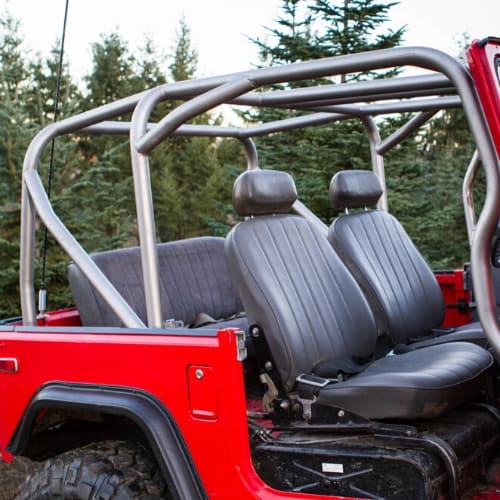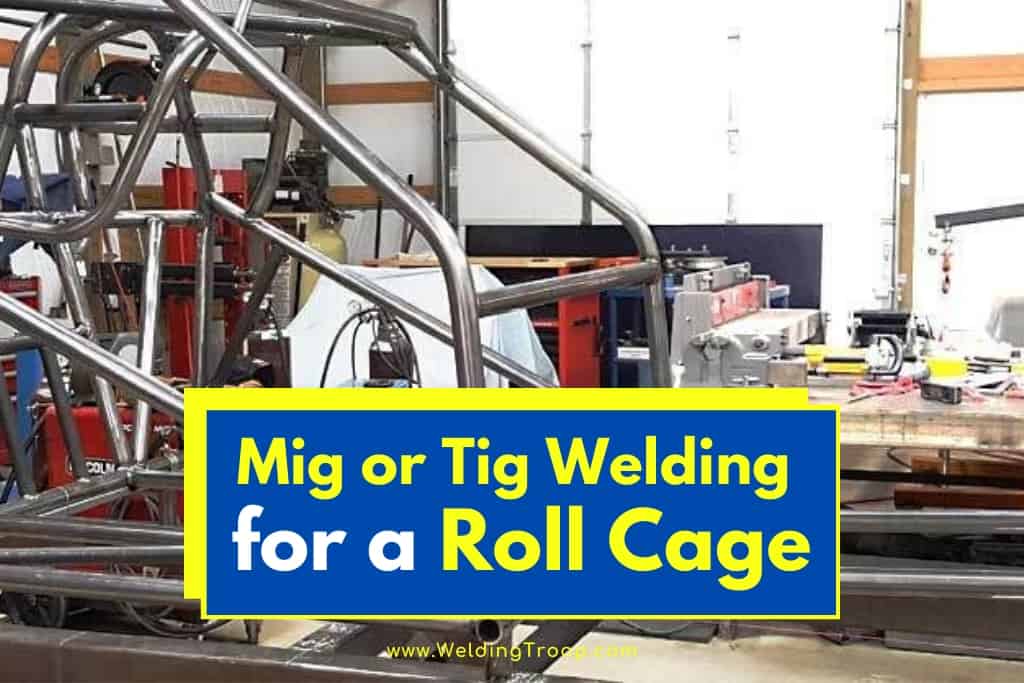So, you have decided to go racing and need to install a roll cage into your car. Every racing association has rules, and most of them are quite detailed in the specifications for roll cages. Once you have determined that you must install a roll cage, how do you decide whether to Mig weld or Tig weld the joints?
Mig or Tig Welding for a Roll Cage. How do you Decide? Several factors determine the type of welding you should use to construct a roll cage.
- Safety
- Association rules may specify which type of welding to use
- The type of material used to make the roll cage
- Welding Skill
Safety is the overriding concern when constructing a roll cage for a racing car. An improperly welded roll cage can be more dangerous than no roll cage at all if you are inside the vehicle during a crash and the parts of the roll cage are flying around broken and unrestrained. Opting for the best welding method should be the only choice. Below is a guideline to determine whether Mig or Tig welding should be used.
Table of Contents
The Safety Aspect
The purpose of the roll cage that you install in your car is to protect you if the vehicle is involved in a crash or wreck during competition. The very concept demands that the roll cage be strong enough to survive the:
- Stresses of impacts
- Rollover
- Other sudden forces
The many welded joints necessary to construct a proper roll cage are the weak points in the construction.
Without a doubt, you want to construct your roll cage from the highest possible quality materials and join those materials with the strongest possible joints. You are, literally, betting your life on the quality of the materials and the welds that you use to join those materials.

From a safety standpoint, it doesn’t matter which method of welding, Mig or Tig, you use to make the welds in your roll cage. Three crucial things to remember when building your roll cage from a safety standpoint are:
- making sure you produce good welds
- Welds should have proper penetration
- Welds should show no defects or deformities
Racing Association Rules
The two largest sanctioning bodies for amateur racing are the Sports Car Club of America (SCCA) and the National Hot Rod Association (NHRA).
While there are many other national and local racing associations covering specialized types of amateur racing or serving local areas, these smaller bodies usually mirror the policies and rules of one of the recognized sanctioning bodies.
If you intend to participate in sanctioned races, you must meet all the safety requirements listed in the rules of the sanctioning body.
Safety inspections are mandatory, and you may even need to provide background information on construction methods and materials used before you will be allowed to compete.
The information provided below is very general. There are so many classes of cars and races outlined by each organization that it is impossible to cover them all in detail in this article.
You must get the rules for the association and the classes of races in which you want to participate, familiarize yourself with them, and follow them to the letter.
SCCA Roll Cage Rules
The SCCA has hundreds of classes and types of racing for which they specify rules and regulations. Each of these sets of rules has specifications for safety equipment, including roll bars or cages, they can be quite specific in their requirements for material, construction, and installation.
SCCA Time Trials and SCCA Road Racing are two of the most popular amateur types of events sanctioned by the SCCA. Both types of sanctioned events have specifications for roll bars or roll cages. In general, these rules specify that:
- Roll bar hoops and all braces must be seamless or DOM mild steel tubing (SAE 1010, 1020, or 1025)
- If you use alloy steel tubing, it must be SAE 4130 material
- No specification on the type of welding, but the rules typically do specify that the welds should be of the highest possible quality with full penetration, no craters, and not undercut by more than .01 inches.
As I have stated before, the SCCA sanctions racing for hundreds of types of cars and racing styles. Each one can have its requirements for roll cage construction and installation. You must be sure that your roll cage meets these specifications.
NHRA Roll Cage Rules
Like the SCCA, the NHRA sanctions a wide variety of racing styles encompassing everything from the regular streetcar wanting to test its performance to full-blown professional racing events.
The NHRA rule book is more than 300 pages long. Each class of racing has its specifications, and even certain models of cars have specific requirements for safety equipment.
We, of course, cannot go into specifics in this article. However, the NHRA Rules in Section 20 specify the general rules for roll bars before a car can go racing in a sanctioned event.
The general specifications from the NHRA include:
- All 4130 chromoly tube must use a TIG heliarc process
- Mild steel welding with an approved MIG wire feed or TIG heliarc process is acceptable
- Welds must be free of slag or porosity
- Grinding of welds is prohibited
Before you start preparing a car for NHRA sanctioned racing, no matter which class you choose, you should obtain a copy of the NHRA rule book and make sure you follow the regulations strictly. In some racing classes, there are more detailed specifications available from other sources.

The Material
Mig welding is more effective on mild steel. While mild steel is usually acceptable to the specifications of the racing association, it tends to be heavier than the corresponding chromoly tubing used to construct roll cages.
Weight is always a factor in racing, so chromoly tubing is typically the preferred choice of material.
Tig welding is much more effective on chromoly tubing than Mig welding. It may be possible to weld chromoly tubing with a Mig welder, Tig welding this type of tubing is easier and produces much cleaner and structurally sound welds.
Related reading: Which Metals Can Be MIG Welded?
Why Is TIG Welding Specified in Some Cases
In many instances, both Mig and Tig welding produce strong and acceptable welds.
However, under certain conditions and in certain materials, Tig welding is the preferred method to produce welds. Some of these conditions and materials include
- The welding of chromoly tubing especially 4130 which some racing rules specify
- Some Mig welders cannot create a hot enough arc to produce adequate penetration
- Generally, Tig welds are considered structurally superior to Mig welds
- Mig welding can involve wide fluctuations in temperature at the weld while Tig ensures an even temperature typically throughout the weld.
One last consideration is the weight of the entire roll cage. Mild steel tubing is heavier walled than chromoly pipe. Mig welding the milder steel adds even more weight to the whole assembly. From a racing point of view, less weight is better in terms of performance.
What is TIG Welding? (GTAW) >> Check out the video below
Skill
Skill can be a factor in the quality of the welds produced by either Mig or Tig. You must be the judge of your skill level if you are constructing a roll cage for your car.
If you have the skill, you can create a sound roll cage using a Mig welder. Overall, for most part-time welders, the choice of the more forgiving Tig welder can make the difference in the quality of the welds you can produce in chromoly tubing.
Before you continue reading, here is an article we wrote about the 3 most important skills a welder needs to learn.
Chose Tig When you Can
The safety issue is the overriding factor in this whole equation. Tig welding produces a more uniform and more structurally sound joint. You are betting your life on the roll cage you are building.
It only makes sense to use the best possible materials and methods. While Mig welding may produce acceptable welds in a roll cage, Tig welds will usually produce a better result and a safer ride in your race car.
MIG Welding Techniques for Building a Mild Steel Roll Cage >> Check out the video below

